Enhancement of the Load Capacity of High-Energy Laser Monocrystalline Silicon Reflector Based on the Selection of Surface Lattice Defects
Abstract
1. Introduction
2. Simulation of Relationship between Lattice Defects and Optical Properties
2.1. Construction of Defect Simulation
2.2. Simulation Result of Band Structure and Dielectric Function
- (1)
- (2)
- The energy level of the monocrystalline silicon was split and became more compact, and new energy levels (defect energy levels) appeared in both defects. The width between the energy levels was narrowed, resulting in easier electron transition between the energy levels [24].
2.3. Simulation Results of Absorption Coefficient and Reflectivity
- (1)
- Given the change in the energy band structure and the increasing imaginary part of the dielectric function of vacancy defect, the reflectivity of the sample surface was elevated within the waveband of 500–1500 nm.
- (2)
- The reflectivity at 500–900 nm was reduced because of the lattice dislocation, and the reflectivity at over 1000 nm was slightly higher than that of the defect-free model.
3. Method of Defect Regulation
4. Performance Test Analysis after Defect Regulation
4.1. Reflectivity Test
- (1)
- The reflectivity sharply increased. Within 1100–1180 nm, the reflectivity values of all four samples evidently increased (Figure 8b), because the intrinsic absorption limit of the monocrystalline silicon was nearly 1110 nm. When the wavelength of incident light was greater than 1110 nm, intrinsic absorption would not be generated, and the reflectivity presented an obvious increasing trend.
- (2)
- The intrinsic absorption limit blue-shifted slightly after the treatment with the combined process.
- (3)
- Within 900–1080 nm, the reflectivity of sample #4 was basically at the same level as that of #3 sample but higher than that of sample #1 by 4% (Figure 9a).
- (4)
- Within 1180–1500 nm, the reflectivity of sample #4 was elevated by 8% compared with that of sample #3. However, the reflectivity of sample #3 was reduced by 2% compared with that of sample #1 (Figure 9b).
- (5)
- The reflectivity on the surface of sample #2 was reduced within the whole frequency band, because the elevated polishing pressure enlarged the thickness of the amorphous layer.
4.2. Discussion
- (1)
- The reflectivity of sample #3 and sample #4 samples relatively increased after atomic vacancy defects were generated through the ion beam process.
- (2)
- The reflectivity was reduced after polishing enlarged the thickness of the amorphous layer (sample #2).
5. Photothermal Weak Absorption Test
6. Conclusions
Author Contributions
Funding
Acknowledgments
Conflicts of Interest
References
- Chen, X.; Liu, C.; Ke, J.; Zhang, J.; Shu, X.; Xu, J. Subsurface damage and phase transformation in laser-assisted nanometric cutting of single crystal silicon. Mater. Des. 2020, 190, 108524. [Google Scholar] [CrossRef]
- Deng, W.-T.; Zhao, G.; Zhang, M.; Chen, X. Design of optical device with co-aperture forhigh energy laser system. Chin. Opt. 2020, 13, 165–178. [Google Scholar] [CrossRef]
- Herms, M.; Irmer, G.; Kupka, G.; Kirchner, N.; Wagner, M. Comparative Study of the Photoelastic Anisotropy of Si and GaAs. J. Electron. Mater. 2020, 49, 1–8. [Google Scholar] [CrossRef]
- Guo, M.; Zhang, Y.; Zhang, W.; Li, H. Thermal damage of monocrystalline silicon irradiated by long pulse laser. Infrared Laser Eng. 2020, 49, 305002. [Google Scholar] [CrossRef]
- Lugomer, S.; Maksimović, A.; Farkas, B.; Geretovszky, Z.; Szörényi, T.; Tóth, A.; Zolnai, Z.; Bársony, I. Multipulse irradiation of silicon by femtosecond laser pulses: Variation of surface morphology. Appl. Surf. Sci. 2012, 258, 3589–3597. [Google Scholar] [CrossRef]
- Zhang, Y.-p.; Xu, H.; Ling, N.; Zhang, Y.-d. Defect study on infrared thin film of 3.8 μm. In Proceedings of the 2nd International Symposium on Advanced Optical Manufacturing and Testing Technologies; SPIE Press: Bellingham, WA, USA; 2006. [Google Scholar]
- Zhiwu, Z.H.U. Short Pulse Laser to Visible Light CCD and the Damage Effect of the Filter Components. Master’s Thesis, National University of Defense Techology, Changsha, China, 2013. [Google Scholar]
- Wang, Y.; Hu, H.; Li, Q.; Fan, Z. Study of weak absorption of the thin film coated on the Si plates. Chin. J. Lasers 2001, 28, 937–940. [Google Scholar]
- Niu, Y.; Dai, Y. Study on the technology of ultra-precision grinding for aspheric mirror of monocrystalline silicon. Int. J. Nanomanuf. 2017, 13, 283–294. [Google Scholar] [CrossRef]
- Zhong, Y. Laser absorption precursor research: Microstructures in the subsurface of mono-crystalline silicon substrate. Appl. Opt. 2017, 56, 8507. [Google Scholar] [CrossRef]
- Feit, M.D.; Rubenchik, A.M. Influence of subsurface cracks on laser-induced surface damage. Laser-Induc. Damage Opt. Mater. 2003, 2003, 264–272. [Google Scholar]
- Li, J.; Fang, Q.; Zhang, L.; Liu, Y. Subsurface damage mechanism of high speed grinding process in single crystal silicon revealed by atomistic simulations. Appl. Surf. Sci. 2015, 324, 464–474. [Google Scholar] [CrossRef]
- Cole, G.D.; Zhang, W.; Bjork, B.J.; Follman, D.; Heu, P.; Deutsch, C.; Sonderhouse, L.; Robinson, J.; Franz, C.; Alexandrovski, A.; et al. High-performance near- and mid-infrared crystalline coatings. Optica 2016, 3, 647. [Google Scholar] [CrossRef]
- Raider, S.I.; Flitsch, R.; Palmer, M.J. Oxide Growth on Etched Silicon in Air at Room Temperature. J. Electrochem. Soc. 2019, 122, 413–418. [Google Scholar] [CrossRef]
- Shen, X. Spectral and Optical Properties of Semiconductors; Science Press: Beijing, China, 2002. [Google Scholar]
- Liu, E. Physics of Semiconductor; Publishing House of Electronics Industry: Beijing, China, 2008; pp. 317–321. [Google Scholar]
- Tauc, J. Amorphous and Liquid Semiconductor; Plenum: New York, NY, USA, 1974; p. 159. [Google Scholar]
- Kumar, V.; Sharma, S.K.; Sharma, T.; Singh, V. Band gap determination in thick films from reflectance measurements. Opt. Mater. 1999, 12, 115–119. [Google Scholar] [CrossRef]
- Guo, X.; Zhang, L.; Jin, Z.; Guo, D. Molecular Dynamics Simulation in Vacancy Defect Monocrystal Silicon Nanometric Grinding. China Mech. Eng. 2013, 24, 1284–1295. [Google Scholar]
- Zhou, L. The Method of Modeling a-SiO2/Si Interface and its Application in Photoelectric Propertis of Ultrathin Gate Dielectric MOS Devices. Master’s Thesis, University of Electronic Science and Technology of China, Chengdu, China, 2015. [Google Scholar]
- Rong, L.; Meng, Z.-J.; Xiao, C.; Zhou, L.; Du, L.-H.; Liu, K.; Du, J.-F. Impact of defects on local optical dielectric properties of Si/SiO2 interfaces by layered capacitor modeling. Appl. Phys. A 2016, 122, 283–1–283–8. [Google Scholar] [CrossRef]
- Zhang, L. Research on Nano—Processing Performance of Silicon. Master’s Thesis, Dalian University of Technology, Dalian, China, 2014. [Google Scholar]
- Robertson, J.; Xiong, K.; Clark, S.J. Band structure of functional oxides by screened exchange and the weighted density approximation. Phys. Status Solidi 2006, 243, 2054–2070. [Google Scholar] [CrossRef]
- Liu, Z.-C.; Zheng, J.-T.; Zhaod, D.-F.; Wum, M.-B. Effects of Forbidden Bandwidth and Optical Absorption Coeffcient on Photocatalytic Ability of TiO2. Chin. J. Lumin. 2012, 33, 1329–1334. [Google Scholar] [CrossRef]
- Xu, J.; Luo, J.; Wang, L.; Lu, X. The crystallographic change in sub-surface layer of the silicon single crystal polished by chemical mechanical polishing. Tribol. Int. 2007, 40, 285–289. [Google Scholar] [CrossRef]
- Xiao, Y.; Fang, F.; Xu, Z.; Hu, X. Annealing recovery of nanoscale silicon surface damage caused by Ga focused ion beam. Appl. Surf. Sci. 2015, 343, 56–69. [Google Scholar] [CrossRef]
- Caturla, M.; De La Rubia, T.D.; Marqués, L.A.; Gilmer, G.H. Ion-beam processing of silicon at keV energies: A molecular-dynamics study. Phys. Rev. B 1996, 54, 16683–16695. [Google Scholar] [CrossRef]
- Shi, F.; Zhong, Y.; Dai, Y.; Peng, X.; Xu, M.; Sui, T. Investigation of surface damage precursor evolutions and laser-induced damage threshold improvement mechanism during Ion beam etching of fused silica. Opt. Express 2016, 24, 20842–20854. [Google Scholar] [CrossRef] [PubMed]
- Liao, W. Investigation of laser-induced damage threshold improvement mechanism during ion beam sputtering of fused silica. Opt. Express 2017, 25, 29260. [Google Scholar] [CrossRef]
- Wang, B. The Research of Fabrication and Testing Technology of the Monocrystalline Silicon Optical Elements with Super-smooth Surfaces. Master’s Thesis, Changchun University of Science and Technology Changchun, Jilin, China, 2005. [Google Scholar]
- Zhang, D.-W.; Zhang, D.-P.; Shao, J.-D.; Wang, Y.-J.; Fan, R.-Y. The application of ion beam cleaning on the laser films. Opt. Tech. 2005, 31, 238–240. [Google Scholar]
- Kuo, P.-K.; Munidasa, M. Single-beam interferometry of a thermal bump. Appl. Opt. 1990, 29, 5326. [Google Scholar] [CrossRef] [PubMed]
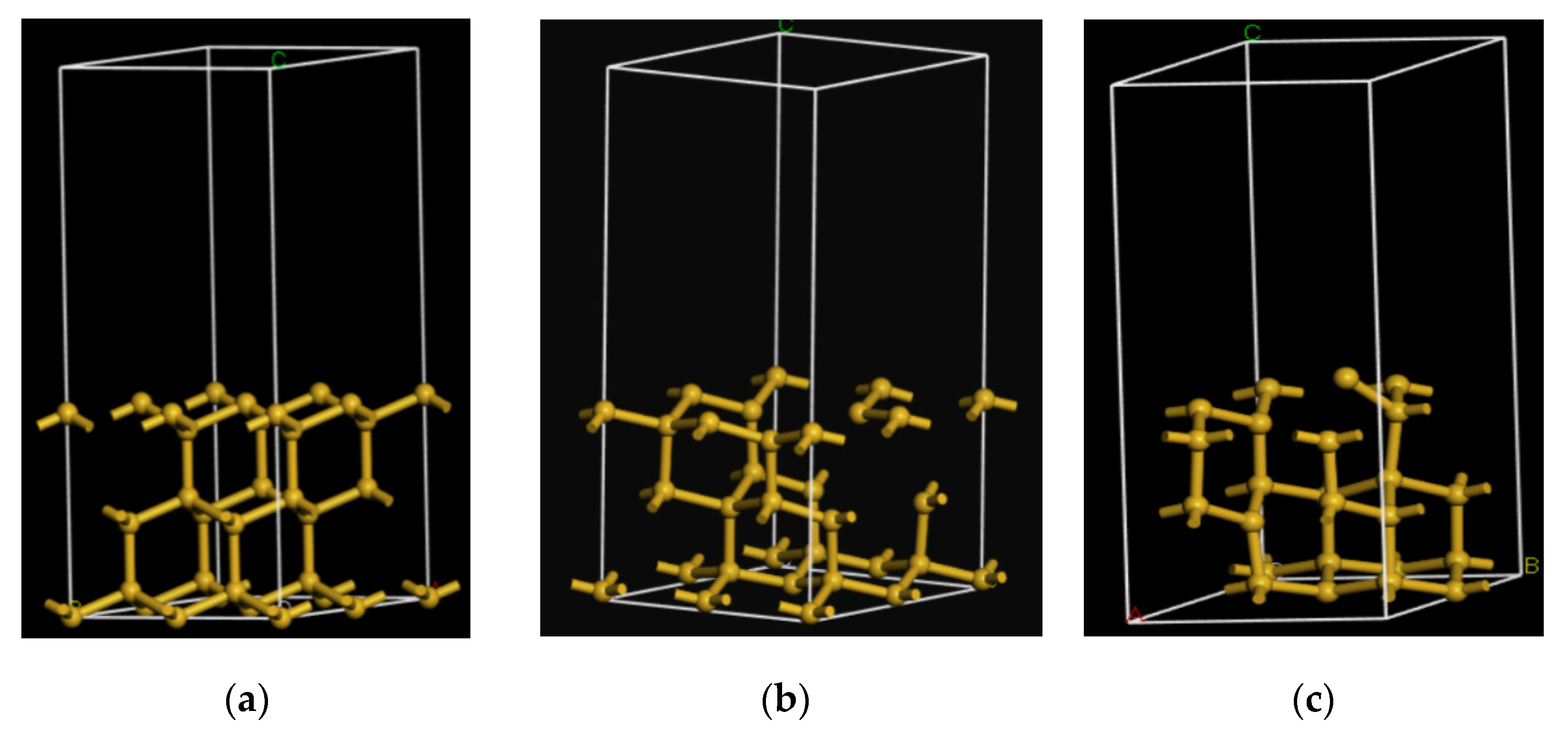

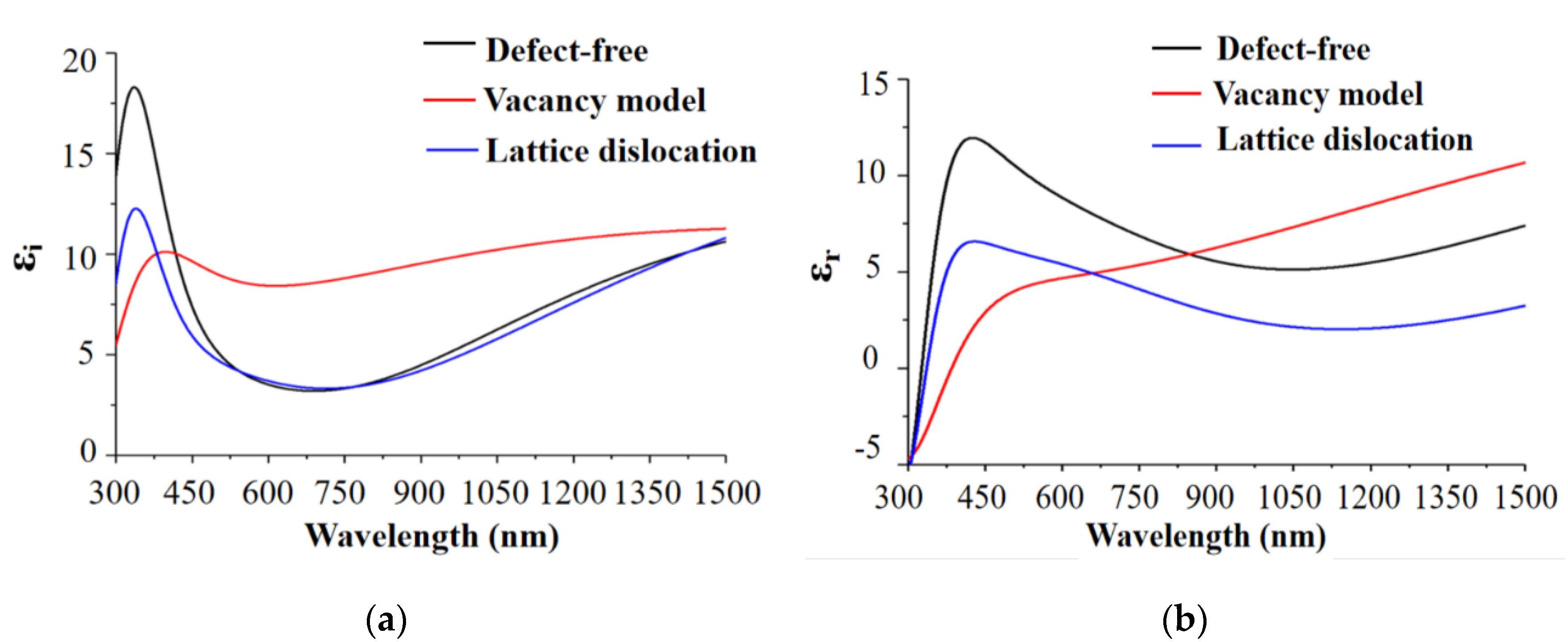
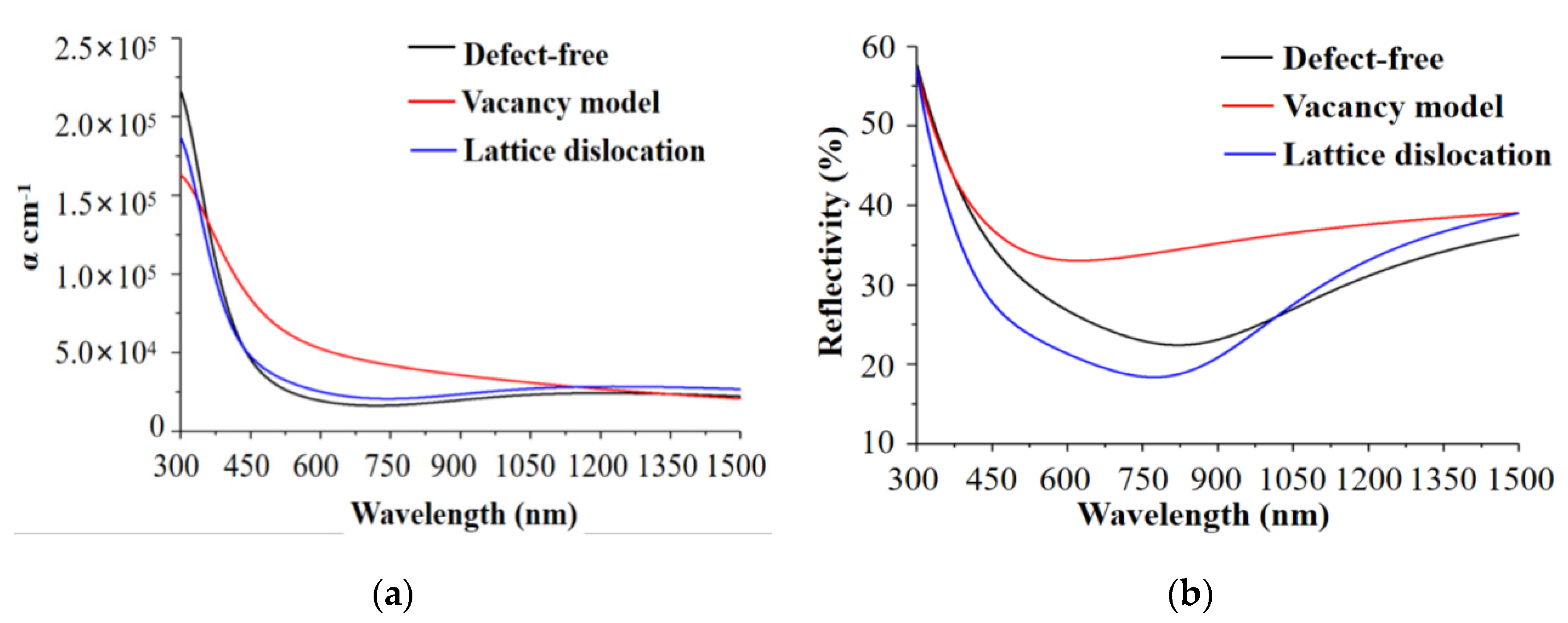
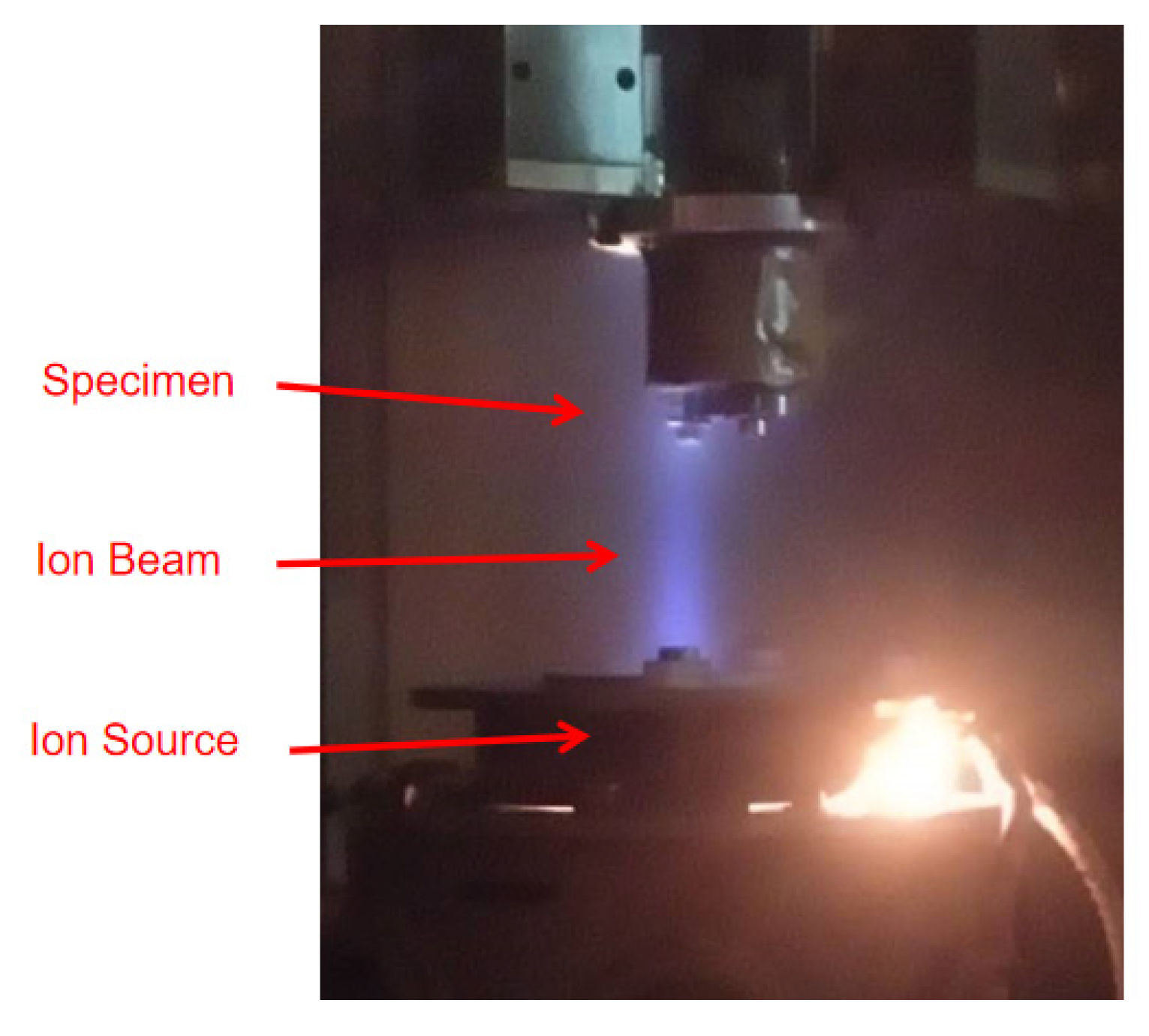

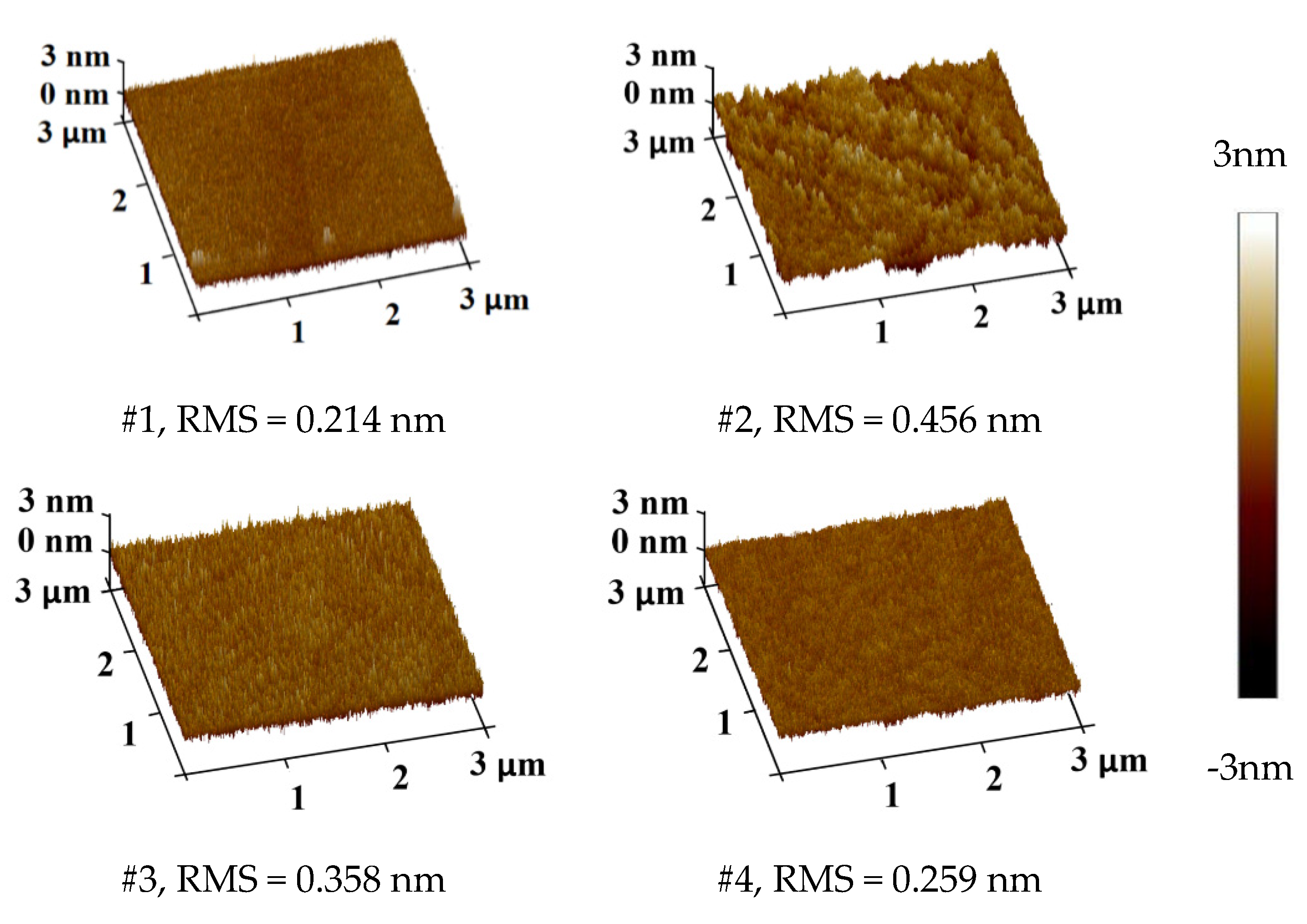
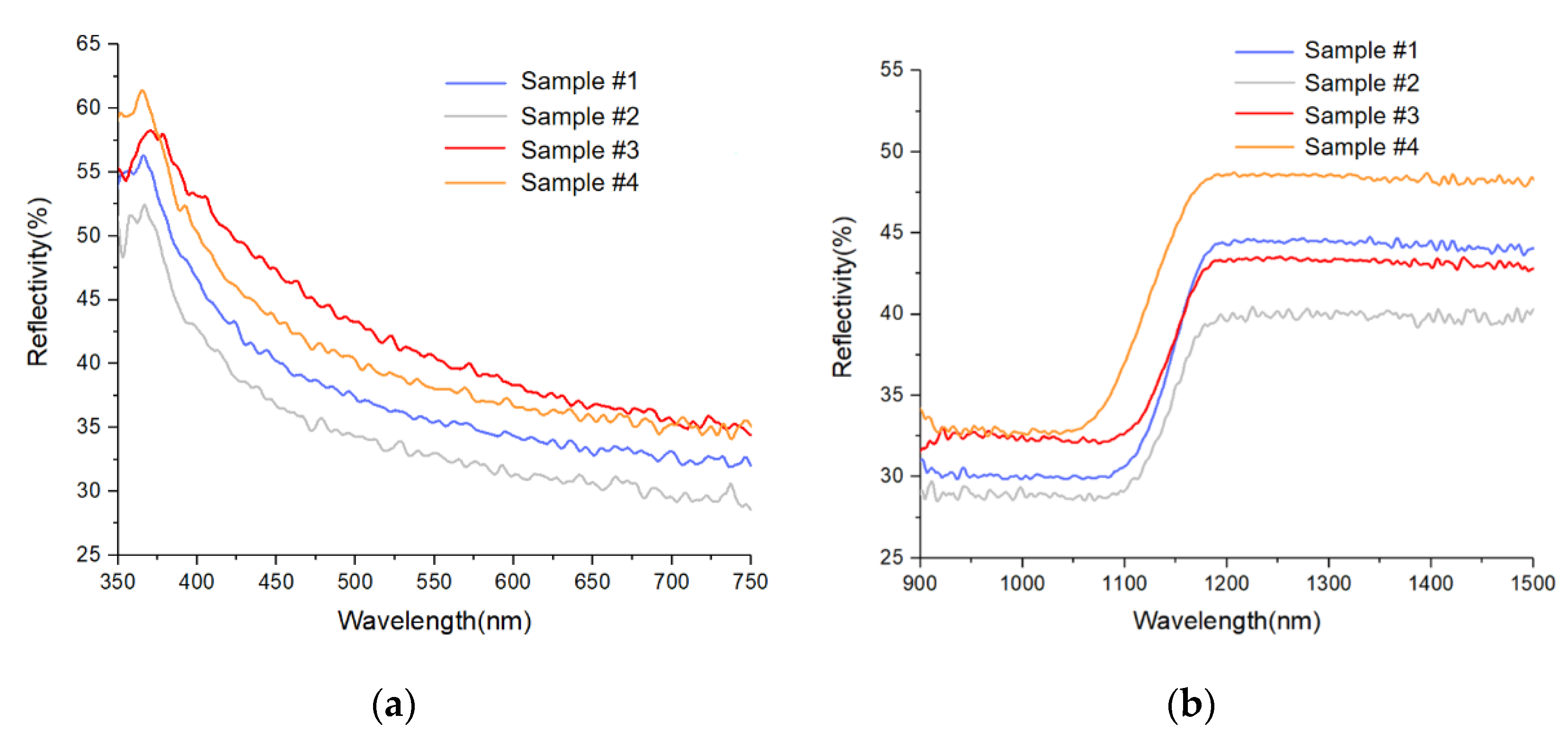

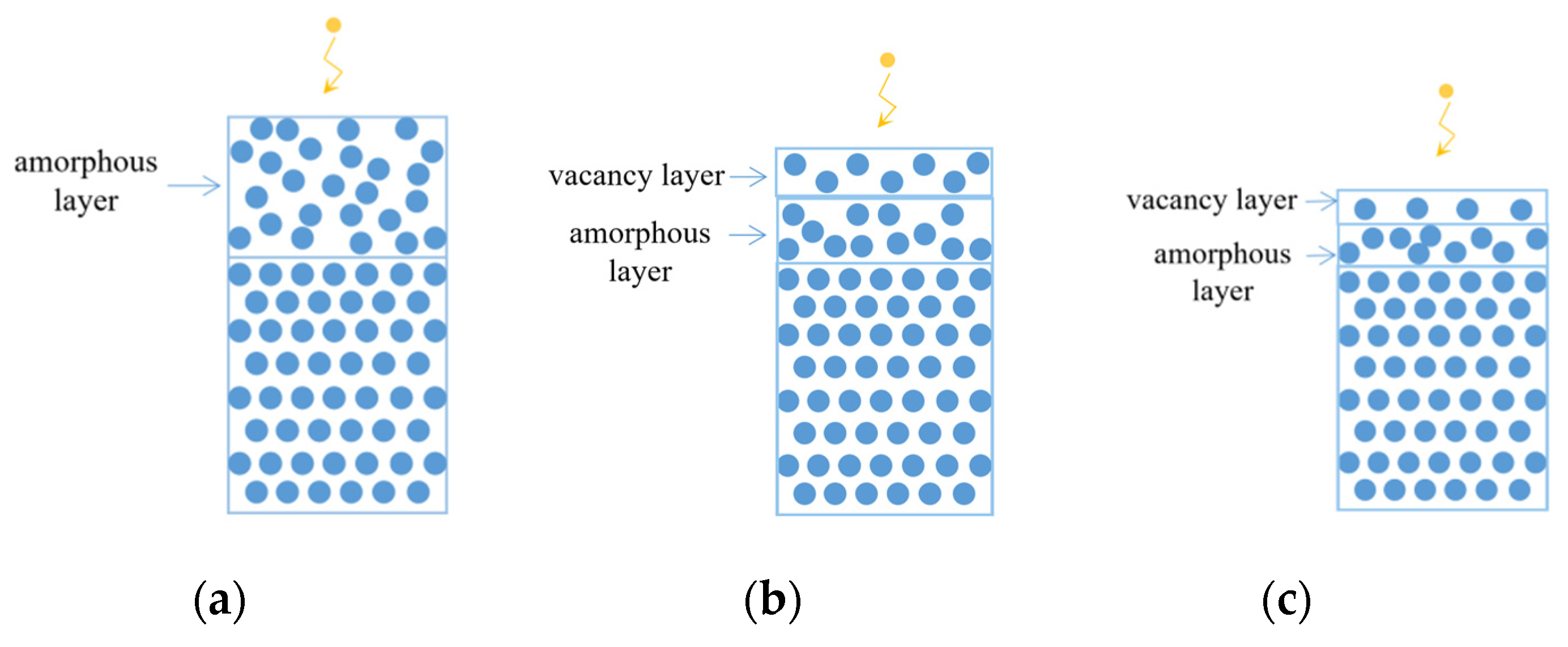


| Item | Level |
|---|---|
| Pseudopotential | Ultra-soft |
| Functionality of exchange energy | GGA-PRBE |
| Self-consistent convergence tolerance | 2 × 10−6 eV/atom |
| Energy cutoff | 350 eV |
| k-point | 2 × 2 × 1 |
| Item | Variation | |
|---|---|---|
| Vacancy Model | Lattice Dislocation | |
| Band gap | Reduced to 0.035 eV | Reduced to 0.076 eV |
| Energy level | Split More compact Defect energy levels appeared | Split More compact Defect energy levels appeared |
| Electron transition probability | Higher than Defect-free | Higher than Defect-free |
| Wavelength (nm) | Reflectivity |
|---|---|
| 500–900 | Vacancy defect > Defect free > Lattice dislocation |
| 1000–1500 | Vacancy defect > Lattice dislocation > Defect free |
| No. | Processing Method | Crystal Orientation | Thickness (mm) | Size (mm) |
|---|---|---|---|---|
| 1 | Nontreated | (100) | 5 | Φ20 |
| 2 | CMP | (100) | 5 | Φ20 |
| 3 | IBF | (100) | 5 | Φ20 |
| 4 | Combined Process | (100) | 5 | Φ20 |
| Item | Level |
|---|---|
| Pressure | 0.01 MPa |
| Polishing agent | Nano SiO2 gel (100 nm, pH 9) |
| Polishing disk | Pitch polishing disk |
| Item | Level |
|---|---|
| Pressure | 0.03 MPa |
| Processing time | 20 min |
| Polishing agent | Nano SiO2 gel (100 nm, pH 9) |
| Polishing disk | Asphalt polishing disk |
| Removal amount | 85 nm |
| Item | Level |
|---|---|
| Voltage | 900 eV |
| Sputtering gas | Argon |
| Base pressure of the chamber | 1.5 × 10−3 Pa |
| Incidence angle | 0° |
| Processing time | 30 min |
| Processing mode | Uniform Scanning |
| Number of Times | Processing Method | Processing Time | Process Parameters | Removal Amount |
|---|---|---|---|---|
| 1, 2 | CMP | 30 min | Polishing pressure: 0.03 MPa Polishing agent: SiO2 gel (100 nm, pH 9) Polishing disk: asphalt polishing disk | 300 nm |
| IBF | 30 min | Voltage (eV): 900 eV Incidence angle: 0° Processing mode: Uniform Scanning | 120 nm | |
| 3, 4 | CMP | 15 min | Polishing pressure: 0.02 MPa Polishing agent: SiO2 gel (50 nm, pH 9) Polishing disk: asphalt polishing disk | 120 nm |
| IBF | 20 min | Voltage: 900 eV Incidence angle: 0° Processing mode: Uniform Scanning | 85 nm |
| Item | Level |
|---|---|
| Angle | 15° |
| Polarization | S |
| Measuring | 15350–1500 |
| waveband | nm |
| Wavelength (nm) | Reflectivity |
|---|---|
| 900–1080 | #3>#4>#1>#2 |
| 1080–1180 | The reflectivity evidently increased |
| 1180–1500 | #4>#1>#3>#2 |
| Sample | Evolution of Surface | Variation of Reflectivity |
| #2 | Thickness of amorphous layer was enlarged | Reduced |
| #3 | Atomic vacancy defects were generated | Increased |
| #4 | Atomic vacancy defects were generated | Increased |
| Item | Level |
|---|---|
| Irradiation laser wavelength | 1064 nm |
| Irradiation laser power | 4 watt |
| Scan size per test | 1 mm × 1 mm |
| Pixel size | 50 μm × 50 μm |
| Test mode | reflective |
© 2020 by the authors. Licensee MDPI, Basel, Switzerland. This article is an open access article distributed under the terms and conditions of the Creative Commons Attribution (CC BY) license (http://creativecommons.org/licenses/by/4.0/).
Share and Cite
Zhou, G.; Tian, Y.; Xue, S.; Zhou, G.; Song, C.; Zhou, L.; Tie, G.; Shi, F.; Shen, Y.; Zhu, Z. Enhancement of the Load Capacity of High-Energy Laser Monocrystalline Silicon Reflector Based on the Selection of Surface Lattice Defects. Materials 2020, 13, 4172. https://doi.org/10.3390/ma13184172
Zhou G, Tian Y, Xue S, Zhou G, Song C, Zhou L, Tie G, Shi F, Shen Y, Zhu Z. Enhancement of the Load Capacity of High-Energy Laser Monocrystalline Silicon Reflector Based on the Selection of Surface Lattice Defects. Materials. 2020; 13(18):4172. https://doi.org/10.3390/ma13184172
Chicago/Turabian StyleZhou, Gang, Ye Tian, Shuai Xue, Guangqi Zhou, Ci Song, Lin Zhou, Guipeng Tie, Feng Shi, Yongxiang Shen, and Zhe Zhu. 2020. "Enhancement of the Load Capacity of High-Energy Laser Monocrystalline Silicon Reflector Based on the Selection of Surface Lattice Defects" Materials 13, no. 18: 4172. https://doi.org/10.3390/ma13184172
APA StyleZhou, G., Tian, Y., Xue, S., Zhou, G., Song, C., Zhou, L., Tie, G., Shi, F., Shen, Y., & Zhu, Z. (2020). Enhancement of the Load Capacity of High-Energy Laser Monocrystalline Silicon Reflector Based on the Selection of Surface Lattice Defects. Materials, 13(18), 4172. https://doi.org/10.3390/ma13184172




